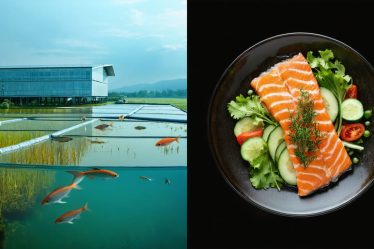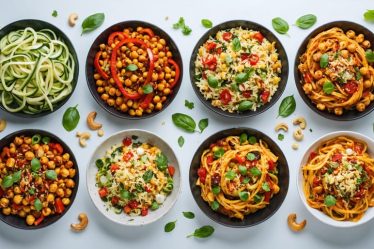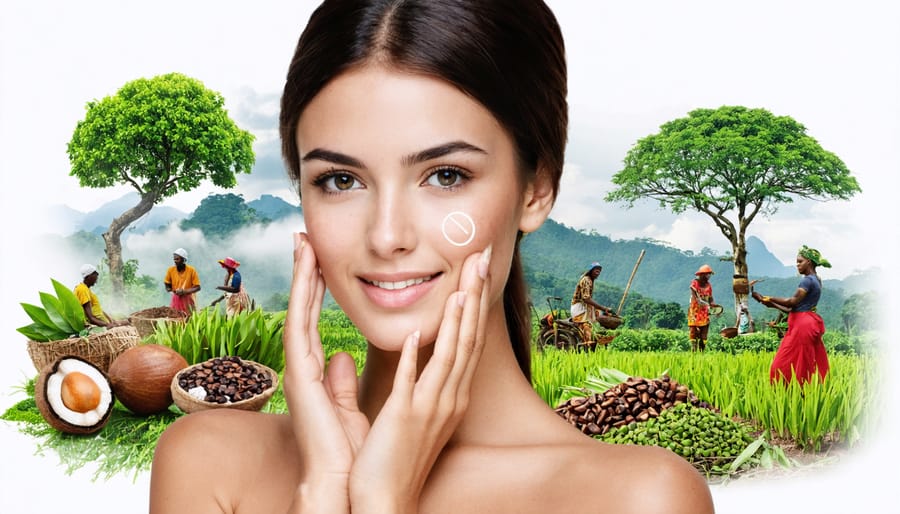
Every purchase you make tells a story – and when it comes to fair trade ingredients, that story can transform lives across the globe. From the coffee beans in your morning brew to the shea butter in your favorite moisturizer, fair trade ingredients represent a powerful commitment to ethical sourcing and human dignity. Picture this: farmers receiving fair wages, communities accessing education, and sustainable practices preserving our planet for future generations – all starting with your conscious choice at the checkout counter.
The beauty of fair trade isn’t just in its ethical principles; it’s in the superior quality of ingredients cultivated by artisans who take pride in their craft. As consumers increasingly seek transparency in their products, fair trade certification has emerged as a trusted beacon of responsibility, ensuring that your self-care routine contributes to collective care for both people and planet.
Whether you’re a seasoned ethical shopper or just beginning to explore conscious consumerism, understanding fair trade ingredients opens the door to making meaningful impact through everyday choices.
Understanding Fair Trade in Beauty Products
What Makes an Ingredient Fair Trade?
For an ingredient to earn its fair trade certification, it must meet strict standards that prioritize both people and planet. Think of it as a guarantee that farmers and workers received fair compensation and worked under safe conditions. When I first learned about fair trade certification, I was amazed by how comprehensive the process is!
The certification process involves regular audits and inspections of farming communities and processing facilities. Fair trade ingredients must be produced without harmful pesticides, and workers must receive wages that actually support their families. Communities also receive a premium payment that they can invest in local projects like schools, healthcare facilities, or clean water systems.
What really makes fair trade special is its focus on long-term sustainability. Farmers are encouraged to use environmentally friendly practices, and there’s a strict ban on child labor. The certification also ensures transparency throughout the supply chain, so you can trust that your purchase genuinely supports ethical practices.
Remember, when you see that fair trade label, it represents countless hours of dedication to creating a more equitable world, one ingredient at a time.

Common Fair Trade Beauty Ingredients
When shopping for fair trade beauty products, you’ll often encounter several key ingredients that make a real difference in both your skincare routine and global communities. Shea butter, sourced primarily from West Africa, remains one of the most popular fair trade ingredients, known for its moisturizing properties. Coconut oil, often harvested in Southeast Asia and the Pacific Islands, appears in everything from hair masks to body lotions. Argan oil from Morocco offers amazing benefits for both skin and hair, while fair trade cocoa butter provides deep hydration in many body care products. You might also spot fair trade honey, vanilla, and essential oils like lavender and tea tree in your favorite natural beauty products. These ingredients not only deliver fantastic results but also support sustainable farming practices and fair wages for workers worldwide.
The Human Impact of Fair Trade Sourcing
Supporting Local Communities
When you choose fair trade ingredients, you’re not just making a purchase – you’re investing in the future of farming communities worldwide. The impact on farming communities extends far beyond fair wages. Fair trade premiums fund vital community projects, from building schools and healthcare facilities to improving local infrastructure and water systems.
I recently spoke with Maria, a cocoa farmer from Ghana, who shared how fair trade premiums helped her community build their first local medical clinic. Now, families no longer need to travel hours for basic healthcare. These premiums also support educational initiatives, providing scholarships for children and agricultural training for farmers to adopt sustainable practices.
What makes this system truly powerful is that communities decide how to use these funds themselves. Whether it’s investing in women’s empowerment programs, environmental protection efforts, or economic development projects, fair trade premiums empower local communities to shape their own future and create lasting positive change.
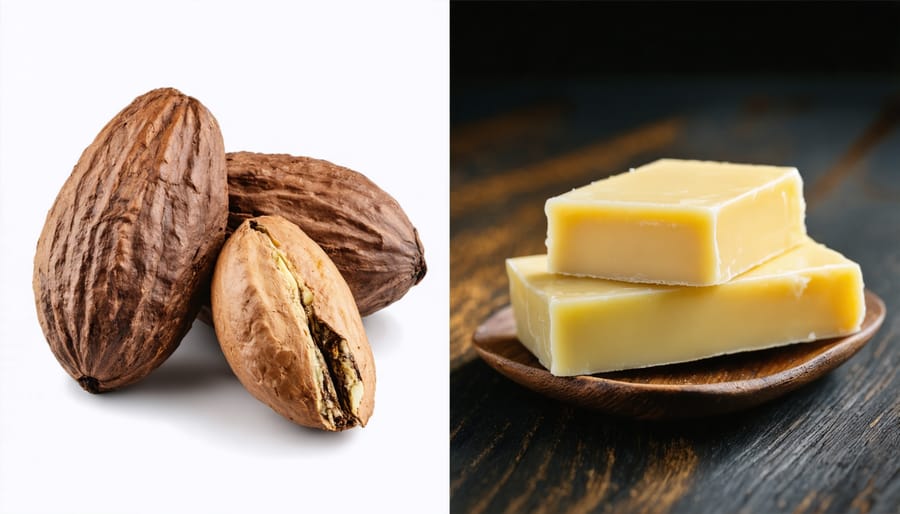
Environmental Sustainability
Fair trade practices go hand in hand with environmental stewardship, creating a ripple effect of positive change that extends far beyond fair wages. When farmers receive fair compensation for their work, they can invest in sustainable sourcing practices that protect both their land and our planet.
I’ve seen this firsthand during my visits to fair trade coffee cooperatives, where farmers proudly showcase their organic farming methods and soil conservation techniques. These practices not only preserve biodiversity but also help combat climate change by maintaining healthy ecosystems. Fair trade certification often requires farmers to avoid harmful pesticides, protect water sources, and maintain forest cover – creating a harmonious balance between agriculture and nature.
What I love most about this approach is how it creates a virtuous cycle: better farming practices lead to healthier soil, which produces higher-quality ingredients, ultimately resulting in superior products for conscious consumers like us. By choosing fair trade ingredients, we’re not just supporting ethical labor practices – we’re voting for a healthier planet with every purchase.
Making Ethical Beauty Choices
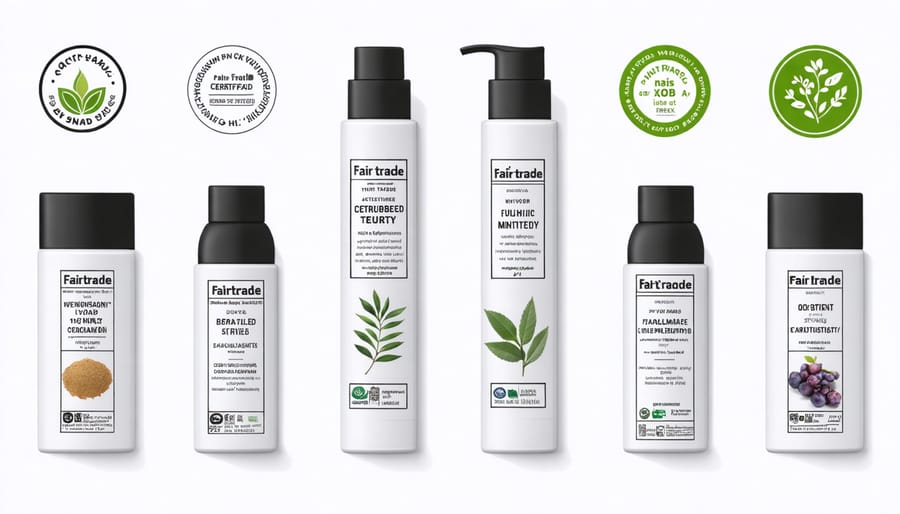
Reading Labels and Certifications
When it comes to making conscious consumer choices, understanding fair trade labels and certifications is your best ally. I remember feeling overwhelmed the first time I tried to decipher these symbols, but once you know what to look for, it becomes second nature!
The most widely recognized certification is the Fairtrade International (FLO) mark – a black and blue symbol featuring a person with a raised arm. This certification ensures the highest standards of fair trade practices. Another trusted symbol is the Fair Trade Certified™ label, which features a black and white design with a person holding a bowl.
When shopping, look beyond just the front of the package. Authentic fair trade products will display their certification prominently, usually on the back label with a certification number. Be wary of vague terms like “ethically sourced” or “sustainably produced” without proper certification – these aren’t regulated claims.
Some brands might use ingredients that are fair trade certified but may not have the certification on their final product. In these cases, check the ingredient list for specific callouts like “fair trade cocoa butter” or “fair trade shea.” The brand’s website often provides more detailed information about their fair trade partnerships and commitments.
Remember, genuine fair trade products will always be transparent about their certification status and source of ingredients.
Brands Committed to Fair Trade
As someone who’s passionate about ethical shopping, I’m thrilled to share some brands that have made fair trade ingredients a cornerstone of their business model. Dr. Bronner’s leads the pack with their commitment to fair trade coconut oil and palm oil, ensuring farmers receive fair wages while protecting local ecosystems. Their transparency in sourcing has set industry standards for over 60 years.
Ben & Jerry’s ice cream doesn’t just taste good – they’ve been pioneers in fair trade ingredient sourcing since 2005, using fair trade cocoa, vanilla, sugar, and coffee in their beloved flavors. Equal Exchange deserves recognition for their extensive range of fair trade coffee, chocolate, and tea products, working directly with small-scale farmer cooperatives worldwide.
The Body Shop was among the first beauty brands to embrace fair trade, sourcing ingredients like shea butter from Ghana and tea tree oil from Kenya. Their Community Fair Trade program has benefited over 12,000 farmers globally. Alter Eco takes chocolate to the next level with their fair trade cacao, proving that indulgence can coexist with ethics.
I especially love how Divine Chocolate stands out – they’re partially owned by cocoa farmers in Ghana, giving producers a real voice in how their products are made and sold. These brands show that successful business and ethical practices can go hand in hand, making it easier for us to shop consciously.
Every time we choose fair trade ingredients, we become part of a larger movement that touches lives across the globe. I remember the moment I switched to fair trade coffee and how that simple decision sparked my journey toward more conscious consumption. It’s amazing to think that our everyday choices in the beauty products we use can help support sustainable farming practices, ensure fair wages, and create better working conditions for communities worldwide.
By choosing products with fair trade ingredients, we’re not just taking care of our skin or hair – we’re taking care of people and the planet too. These choices ripple outward, supporting education initiatives, healthcare access, and community development in farming regions that might otherwise struggle to provide these essential services.
As we move forward in our beauty and wellness journeys, let’s remember that each purchase is a vote for the kind of world we want to create. Together, we can build a more equitable beauty industry where quality products and ethical practices go hand in hand. Your next beauty purchase might seem small, but it’s part of something much bigger – a global movement toward a fairer, more sustainable future for all.

